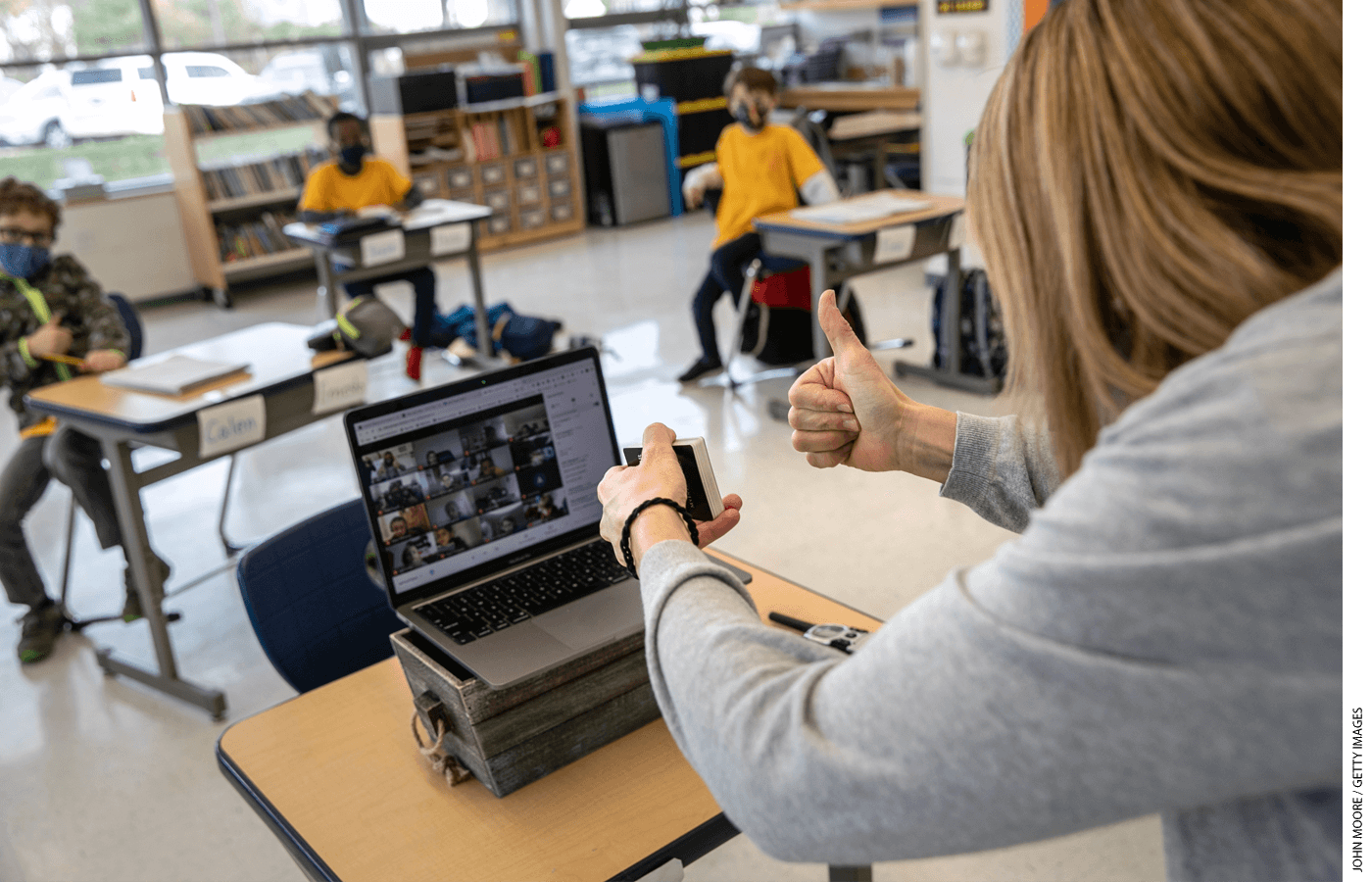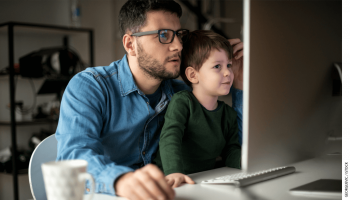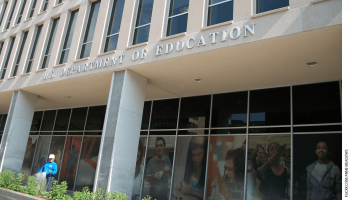
A crisis like a pandemic can spark unpredictable alterations in trends and behavior, like widespread mask wearing in the usa. But it also can accelerate changes that were already underway but otherwise would have taken root much more slowly. For instance, working remotely would be a relative rarity in early 2021; now many organizations may never again expect all employees at work 5 days per week. And outdoor eating spaces, an occasional curiosity in some cities, have put their hands up all over the place. Lots of cities and small towns have made it clear that they would like to keep this innovation despite the crisis recedes.
So too in the realm of K -12 education, where some new pandemic-era practices are likely to persist in the future. A few of these are simple and straightforward. Using Zoom for parent-teacher conferences and PTA meetings makes life easier for working parents. Online curriculum materials instead of printed textbooks could also have staying power, since so many students have Chromebooks or any other internet-connected devices. Others are more difficult, such as recording a school's or district's best teacher giving key lessons and using those videos in multiple classrooms. That releases other teachers to supply support and individualized instruction-a nimble, but politically sensitive, way to rework teachers' roles and use technology to enhance instruction (see \”How Big Charter Networks Switched to Remote Learning,\” feature, Spring 2021).
But as both good sense and classic conservatism would submit, not all of the changes that have occurred in education throughout the pandemic are positive. And merely because there are some innovations that we should make an effort to maintain within the post-Covid era, there are others we ought to bid farewell to.
Here are my top five-including several that are close cousins (perhaps evil cousins?) more promising ideas.
First, and perhaps most obviously, we should no more ask teachers to teach 1 / 2 of their students personally and the partner remotely simultaneously. Randi Weingarten, president of the American Federation of Teachers, named it \”not humanly possible\”-and she's right.
This hugely unpopular \”concurrent\” model is surely the worst of both worlds, as being a videoconference with half the participants personally and half signing in from afar is especially unworkable. We all know that, done correctly, remote instruction can function well for many teachers and students. But not when teachers will also be trying to engage students in person at the same time. There's little question this approach has established an enormous amount of stress for teachers along with a subpar learning experience for children.
Careful readers might wonder how I can square this with my previous advocacy to keep teachers' cameras turned on once everybody returns to the classroom (see \”A Post-Covid Case for Classroom Cameras,\” Spring 2021). And that's a good question. As I (yet others) see it, it's much more manageable for teachers working in a live classroom to possess a handful of students following along in your own home, or perhaps watching later using a recorded lesson, than try to engage exactly what the Center for Teaching Quality calls \”Zoomies and Roomies\” instantly. If children are home sick or down the hall due to in-school suspension, administrators makes it clear that teachers are not expected to ask them or else engage them. But allowing absent students to look at what is happening at school is better than nothing at all.
There may be some enduring need for remote learning in the months and years ahead, specifically for medically fragile students. Additionally, as Nyc has decided, districts may eliminate \”snow days\” and keep school virtually open when buildings are closed because of snow. Districts should offer robust online-learning choices to families that are looking it-either by partnering with companies who focus on this or by standing up their own programs. However this should be outside of in-person instruction.
We desire to make similar distinctions using the second item on my list: the cancellation of so-called \”seat-time\” requirements, which award course credit with different minimum quantity of instructional time. Because of the requirement for social distancing, and the public-health priority of keeping adults and kids safe, many states understandably waived requirements that schools hold session for any certain quantity of hours or days in 2021 and 2021, while allowing students to advance through their classes. Likewise, states temporarily let go of many or all mandates dictating the amount of hours invested in particular subjects.
Education reformers who've been advocating for mastery- or competency-based learning were excited about that development, as moving away from seat-time rules was something they have advocated for years. But throughout the pandemic, many states simply got rid of seat-time requirements without substituting other things in exchange. They didn't ask schools to make sure that their students demonstrated competency in critical subject areas, as adopting mastery-based learning standards would require. Nor did they make sure the kids were getting the comprehensive educational experience that states are morally and legally obligated to provide.
By every means, let's continue to experiment with ways to move towards competency-based programs, especially for older students. But in the end work towards that vision, we need to put those seat-time requirements back again.
The reason relates to my third item among the list of \”innovations\” that should go away: so-called \”asynchronous\” learning days, which are school days without live, or \”synchronous,\” instruction. In Montgomery County, Maryland, where my two sons attend traditional public schools, every Wednesday is asynchronous. The idea, as far as I can decipher it, is that custodians would spend Wednesdays doing deep cleaning (which is now thought as \”hygiene theater\”), while teachers provides individualized instruction towards the kids who need it most. Meanwhile, the majority of students would do independent work from home.
I don't believe I'm ratting out my sons by reporting, though, that hardly any independent work was happening on Wednesdays, beyond some regular homework that would and really should be anticipated every day of the week. Without a clear plan, \”asynchronous\” days are simply additional time off.
I am broadly in favor of allowing schools to test out new schedules. For example, \”half-time high school\” could include childbirth study from home several days a week, or hrs a day, or perhaps shift to some college-like schedule, with increased time for independent work. But that is not what happened throughout the pandemic. If so, some school districts simply threw in the towel on providing a five-day-a-week educational experience for their students and expecting students to set up effort every single day, as well. A recent study discovered that, before the pandemic, districts and schools that downshifted to some four-day school week rarely offered meaningful learning opportunities for students on the fifth, out-of-school-day, and student test scores in math and reading declined (see \”The Shrinking School Week,\” research, Spring 2021). There isn't any reason to keep asynchronous learning days once the pandemic has ended.
The fourth big change that isn't worth celebrating may be the rampant increase in grade inflation. When the school shutdowns struck early in the year of 2021, many districts decided it would be unfair to use normal grading policies for that fourth quarter, given the unevenness of use of remote learning. Some simply assigned students the grades they had already earned by mid-March or, like my home district of Montgomery County, rounded up their mid-March scores to another highest letter grade. Others now use pass-fail systems.
Those policies could be defended during an emergency, however the downside is obvious. It sends a clear message that kids won't be held accountable for paying attention, doing their homework, and learning new material. Until we get to the day when intrinsic motivation is enough to get most children and teenagers you prioritized their schoolwork (in other words, never), or when we've transitioned to a system centered on mastery, we're going to need grades to obtain kids to put in the necessary effort (see \”The Case for Holding Students Accountable,\” feature, Spring 2021).
Finally, let us never again decide to graduate tens of thousands of students from high school regardless of whether they mastered learning expectations or otherwise. A cynic might say that high schools and college systems have been doing that for years, and in some parts of the nation, that may be true. Before the pandemic, within 20 states, students were likely to pass some kind of exit exam or end-of-course exam to graduate (though time continues to be trending down). And in others, students had to pass a certain quantity of courses to be able to earn that diploma.
States canceled those examination mandates in 2021 and 2021, for self-evident reasons. But school districts waved the white flag as well, patting on their own the rear for graduating kids whether or not the scholars had even come close to meeting standards. In Chicago Public Schools, for instance, officials celebrated a record-high graduation rate after easing graduation requirements and shifting to a pass/incomplete grading system. It had been essentially impossible for college students to fail.
To make sure, helping more students graduate senior high school is definitely an urgent goal. It urgently vital that you make certain they graduate well prepared for what's ahead. It will students little good to pass them along and give out diplomas without ensuring the kids can see, write, and do math at an accomplished high-school level. Consider Miami-Dade County Public Schools, where a recent overview of high-school achievement found a majority of students failed state tests in English, math, and science, regardless of the district's graduation rate of 85 %.
Let's return to good sense: if your high-school diploma doesn't reliably guarantee the absolute minimum base of knowledge and skills, then we have formulated an insurance policy that punishes graduates who earned their diplomas however don't have any way to signify to employers that they achieved something worth watching. We're also signifying to students who've not fully earned their diplomas that they are ready for life after high school, and they are not.
It's be a cliché to say that, post-pandemic, American schools shouldn't attempt to return to normal. That's true in many respects. But in some cases, back to normal is exactly where we need to go-the sooner, the better.





